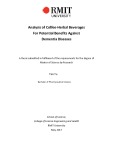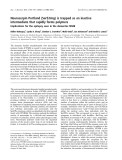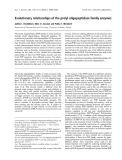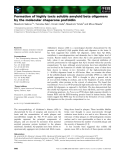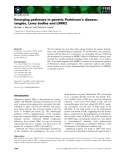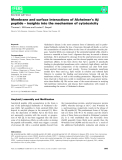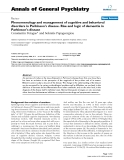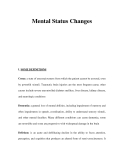
Dementia diseases
-
Master's thesis of Science "Analysis of coffee-herbal beverages for potential benefits against dementia diseases" is structured as follows: Chapter 1: Introduction; Chapter 2: Coffee herbal bioactive compound’s potential to prevent dementia; Chapter 3: The analysis of coffee herbal beverages; Chapter 4: Coffee herbal beverage sensory estimation; Chapter 5: Conclusions and further work; Appendix 1: Herbal coffee beverage sensory analysis evaluation.
 100p
100p  runthenight04
runthenight04
 02-02-2023
02-02-2023
 6
6
 4
4
 Download
Download
-
The dementia familial encephalopathy with neuroserpin inclusion bodies (FENIB) is caused by point mutations in the neuroserpin gene.We have shown a correlation between the predicted effect of the mutation and the number of intracerebral inclusions, and an inverse relationshipwith the age of onset of disease. Our previous work has shown that the intraneuronal inclusions in FENIB result from the sequential interactionbetween the reactive centre loopofone neuroserpin molecule withb-sheet A of the next. ...
 0p
0p  awards
awards
 05-04-2013
05-04-2013
 32
32
 3
3
 Download
Download
-
The prolyl oligopeptidase (POP) family of serine proteases includes prolyl oligopeptidase, dipeptidyl peptidase IV, acylaminoacyl peptidaseandoligopeptidase B.The enzymes of this family specifically hydrolyze oligopeptides with less than 30 amino acids.Many of the POP family enzymes have evoked pharmaceutical interest as they have roles in the regulationof peptide hormones and are involved in a variety of diseases such as dementia, trypanosomiasis and type 2 diabetes.
 11p
11p  dell39
dell39
 03-04-2013
03-04-2013
 58
58
 4
4
 Download
Download
-
Amyloid-b(Ab) aggregation and amyloid formation are key pathological features of Alzheimer’s disease, and are considered to be two of the major contributing factors to neurodegeneration and dementia. Identification of small molecule inhibitors that are orally available, have low toxicity and high central nervous system bioavailability is one approach to the potential development of a disease-modifying treatment for Alzheimer’s disease.
 12p
12p  media19
media19
 06-03-2013
06-03-2013
 49
49
 2
2
 Download
Download
-
Alzheimer’s disease (AD) is a neurological disorder characterized by the presence of amyloidb(Ab) peptide fibrils and oligomers in the brain. It has been suggested that soluble Ab oligomers, rather than Ab fibrils, contribute to neurodegeneration and dementia due to their higher level of toxicity.
 12p
12p  vinaphone15
vinaphone15
 28-02-2013
28-02-2013
 34
34
 2
2
 Download
Download
-
The last decade has seen clear links emerge between the genetic determi-nants and neuropathological hallmarks of parkinsonism and dementia, notably with the discovery of mutations ina-synuclein and tau. Following the description of mutations in LRRK2 linked to Parkinson’s disease, char-acterized by variable pathology including eithera-synuclein or tau deposi-tion, it has been suggested that LRRK2 functions as an upstream regulator of Parkinson’s disease pathogenesis.
 10p
10p  vinaphone15
vinaphone15
 28-02-2013
28-02-2013
 30
30
 3
3
 Download
Download
-
Alzheimer’s disease is the most common form of dementia and its patho-logical hallmarks include the loss of neurones through cell death, as well as the accumulation of amyloid fibres in the form of extracellular neuritic pla-ques.
 13p
13p  cosis54
cosis54
 09-12-2012
09-12-2012
 42
42
 4
4
 Download
Download
-
REVIEW ARTICLE Hanna Willander1,2, EriThe BRICHOS domain was initially defined from sequence alignments of the Bri protein associated with familial dementia, chondromodulin associ-ated with chondrosarcoma and surfactant protein C precursor (proSP-C) associated with respiratory distress syndrome and interstitial lung disease (ILD). Today BRICHOS has been found in 12 protein families.
 12p
12p  cosis54
cosis54
 09-12-2012
09-12-2012
 47
47
 3
3
 Download
Download
-
Tuyển tập các báo cáo nghiên cứu về y học được đăng trên tạp chí y học General Psychiatry cung cấp cho các bạn kiến thức về ngành y đề tài: Phenomenology and management of cognitive and behavioral disorders in Parkinson's disease. Rise and logic of dementia in Parkinson's disease...
 9p
9p  thulanh10
thulanh10
 09-10-2011
09-10-2011
 62
62
 4
4
 Download
Download
-
Agitation (dễ cáu gắt) is an unpleasant state of extreme arousal, increased tension, and irritability anxiety (lo lắng) Fear or apprehension or dread of impending danger and accompanied by restlessness, tension, tachycardia, and dyspnea unattached to a clearly identifiable stimulus.
 7p
7p  truongthiuyen1
truongthiuyen1
 09-06-2011
09-06-2011
 69
69
 5
5
 Download
Download
-
Coma: a state of unconsciousness from which the patient cannot be aroused, even by powerful stimuli. Traumatic brain injuries are the most frequent cause; other causes include severe uncontrolled diabetes mellitus, liver disease, kidney disease, and neurologic conditions Dementia: a general loss of mental abilities, including impairment of memory and often impairments in speech, coordination, ability to understand sensory stimuli, and other mental faculties.
 4p
4p  truongthiuyen1
truongthiuyen1
 09-06-2011
09-06-2011
 66
66
 4
4
 Download
Download
CHỦ ĐỀ BẠN MUỐN TÌM









